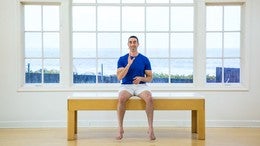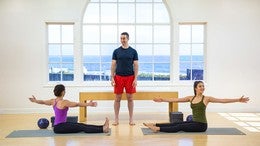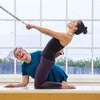Description
About This Video
Transcript
Read Full Transcript
Hi, I'm Jared Kaplan. Thanks for watching this hip hinge tutorial. Here's the deal, please. Repertory, we do lots of amazing things with our feet in the air and on various positions on the apparatus, but one of the most functional things that we need as humans and as people and as athletes and dancers and everyday Joe Schmoes is the input from the ground through our pelvis out the spine. So what I want to talk you through today is a simple series that I designed to look at, how we can stimulate the feet through the pelvis and out the rest of the body from a closed chain position to open chain movement, what it's going to look like. Cause we can go through an unsteady environment, a steady environment, and then a loaded environment with friend from my help Marimba here to demonstrate, we'll take you through a couple of props and we'll show you a ways to transition that to the apparatus. So let's go. I have these half of our balls. Thank you John Claude West. We're going to start with these underneath room, his feet in an unsteady, really mobile environment. So I'm going to help her get on here.
If you're doing these by yourself, you want to go with your heel first.
She can roll a little bit front back if she gets her weight going.
Femurs excursions in the hip joint. Marimba is going to settle. She's gonna feel her center line from her whole spine through her heel and we're just gonna have her bend her news and do a symbol, flat back position as she goes down. She's going to take her time as she comes all the way up, focusing on the extension of her hip joint while really tracking her steady feet. Let's do that again. So I want a slow tempo. So you give your body and your nervous system a chance to sense what's happening from the feet in this unstable environment all the way through her pelvis and then her spine. Let's give her two more to go.
I'm going to give herself enough repetitions that you feel like you've primed this pattern as you're doing this and you sense any discrepancies between the feet. Slow down if you need to, and really make sure that all four balls are even the weighted great. She's going to come off of the balls. It's that simple and she's gonna repeat the exact same pattern in a stable environment. Standing. So in standing that we've primed her nervous system.
I want her to feel her feet really steady from the ground, focusing on pelvis, going through the femurs, through the heels and all the way up her spine taking care at the top that she gets full hip extension, not hanging out in a mini crease, but really driving through the ground to get all the way up to a vertical. Two more times please. So the sensory information she's getting from the sole of her foot through her heel, up and out through her leg, through the entire pelvis with both legs working is really key and we see it and we will see it later in all the apparatus. Okay. Now we've done both of those. We're going to go to the mat and she's going to do a simple version with just her lower leg, stable upper hips.
Upper legs are going to move through to extension. So up onto the mat here. Nice relaxed, comfortable position. This takes the fee out of it. So while we looked at the fee in an unsteady environment, we're now taking the feet completely out of the equation so she can can really focus on her pelvis driving the motion. So I'm going to have her come to tall kneeling, and as she sits back, I want you to notice that she's gonna fold first as opposed to just sitting straight down in a squat. So finding the timing of this folds, getting her hips on her heels, and then coming right back up and she can fold forward again to preload the work of her glutes than driving through on this diagonal to get her pelvis to come back to tall, kneeling, slow work as she essentially controls the descent, trying to really anchor through her whole Shin Nice and easy through the spine. We'll go one more time driving from the Shin on that diagonal all the way back up. Great.
Now for a little more fun. I want to go back to the feet. Should we seek to get to join me here? If you have a half roller, it'll work fine. We're gonna use this. She's going to stand and face me. Now I'm looking at where the apex of her feet are balanced on this surface. So she's going to really feel the center point of her arch right on top of this, I'm going to give her a moment again to acclimate and we're just going to do the same exact pattern. So in standing she's going to go into her bend and I'm going to walk and see and she's going to feel if she veers forward or back side to side.
Shouldn't be too much of an issue here with both legs working
So if you watch her feet, how her lower limb, her upper leg and her pelvis all work together in concert with her spine. We've prepared her with an unsteady environment where her nervous system and her motor control had to really ramp up and we've progressed to a more stable environment and now we're into load. So really going through a micro to a macro progression helps her body really perform the movement in a much more easeful and rich
She's not influencing the spine with any excessive rounding or extension and really feeling that ground force through her feet out the top of her spine.
I'm going to reach a little bit to prep since I haven't done the whole series, I'm gonna make sure I get this moment of full hip extension. Let me do a couple of years just to show you where it goes and I'm really thinking through with my intention, the same patterning and I'm just gonna let it go. Same practice, feeling the connection of my feet through the ground
We're going to flip it and face backwards because I like the range of motion that we can get through the feet without them being stuck on the, uh, the shoulder pads. So in room is going to come onto her knees facing the back of the reformer. I got a sticky pad here for her feet just to get, she gets a little more traction. First rounders, to warm her up a little bit is to simply her knees up and back down. Let's prep that. So she really feels the connection from her feet through her arms.
Nice and steady. So simple. Quadrupedal position, getting the hip fold, getting her core to work up as she lifts, work up and wake up as she lifts. Good. Now she's going to lift her knees up. She's gonna hold. She's going to press out flat back as she comes in. She's going to think of piking and folding forward. As she lifts her tail, she's going to go back out. As she bends, thinking at that same swing she felt in Sanding, so we've just inverted the position. She's still really active from her feet. Thinking back to those balls now using the upper body to help influence her trunk extension. Here's that same hip extension. Really clear, slow motion as she lifts her tailbone up, drops her head a little bit and you one more time and give me a little bit more of a Bal through your trunk so you let it really swing. Tail Up, head down.
There you go. One more for fun. Reach out, strong through the feet, tail up, torso down. Great and rest and he's back down. Now we're going to turn it around. We're going to go into up stretch. Same pattern, a little bit of a longer lever because your legs are straight. Her feet are still going to be really active, so she's going to get herself set up. Give her a moment here to really anchor from her feet through her arms out this same diagonal we've seen from the tailbone. She's going to press on out.
I'm just going to have her focus on that. Rita, she slides republics up in space, bringing the carriage back home, really releasing the head as she goes, pressing out again, looking again for this same moment of hip extension and then releasing in deflection but still anchoring through the feet and again, two more times reaching out. Beautiful. Taking her time as she lets her femur plug into her hip socket. Great. And then use back down.
We have a sticky pad here, so she is nice and stable. She's gonna take her arms out to the sides. She's just going to press straight out from here. We're going to add a little bit of rotation as she comes back around. Good. And do that to the other side as well.
So straight out rotating now to the left just to get her torso moving a little bit. Good. This time she's going to add a bend as she rotates. So Ashley comes in, hinge in through, here's this same moment of folds with a spinal twist, literally coming back up and again side's split with a twist. Beautiful and Baca. Now I know Marimbas body, she tends to hyperextend her knees a little bit, so we're just going to monitor as she goes out so she feels a little more influenced through her hamstring, especially in this phase. Emotion leaning forward if you can. Thank you. Great. And back up. She's gonna keep going for three more reps.
I'm going to remind her where she felt her weight on the balls before because right here she be falling off the back edge of the ball if she doesn't keep using her toes. Great. Good job. Same intention. Where's your weight? Yeah, I know it's working. Breathe and reach back up. Good. Finishing this [inaudible] side.
So let's get her into flat back first. She's going to press all the way out and then I want her really slowly control this moment as she loads from the feet and out the spine. She has a lot of hip flection if we wanted to, whatever. Do Two more reps here?
Now we have her seated different planes of motion, different gravity input on her spine and especially through her feet. Obviously with the springs now she has to work in a different way to ground from her legs all the way through her body. Variations of course could be she can bring her feet down. She didn't have that much range. Are Your clients don't she can do the same thing right here. Good.
And just do one more of those so we can see it now a little more challenge to be with her arms off. She's going to bring them forward and keep this pattern going. She has to work or balance a little more. Now with the Kettlebell before she had a lot more load. This is a different challenge for her spine to really control her body as it moves through space against the challenge of the spring, we're going to add a twist or mimic what we did on the side split.
You got it for way
Great.
Just to show you this maybe four or five times you can just visualize input from the feet. She's obviously not using the sole of the foot, but I wanted to think about that placement as if she were standing on a wall
So then we're going to go into a pull up for that same you centric phase of work for her hip joint. Bring her feet up nice and easy. I want her to first come right to a flat back position. So her brain is already processes and breathing. If she starts really sort of tailbone like you just saw again watching her knees, letting her tailbone release as her feet stay a bit active, loaded east centric phase of movement and then back to concentric.
Let's make it a little more challenging as she comes back into this east centric phase. I want her to slowly bend her knees towards her chest, coordinating the timing like she did with the Kettlebell swing or the standing bend.
So I want her to start here so she can get the stretch as she goes forward. I'm going to spot her here. Here's that same hip bend or hip hinge that far as plenty for now. Now the bar is going to kind of help, but she has to work through her upper body. Now thinking back to her feet where they were on the balls, go ahead and stand on up. Bring the borrower with thinking your pelvis coming towards the bar. And again, I want her to think through with the intention that her feet are the driver, even though she has all this other stuff going on. The way you go.
I know she's got this
Then I'm going to have her come back onto her back. We're going to do parakeet on the Cadillac as well.
So I want her to go first into hip extension. Great. And then again, that tailbone cue of creasing at the hip joint to come back to the mat. Once she's there, she'll fold her news. Now, if we were to take a pause right here and you think back to the other exercises, we've looked at, same position, flipped on her back with the load. She's going to press up going through both legs, threw her feet back into extension. Good. Drive up a little more. There you go. Then slow control.
She's going to be careful of her knees. She's going to let her table and do the work as she comes back down, flat back. I'm going to monitor. She's still working. We're not just falling to the ground here. Deep Hip crease. Then the knees can go. She can press on through. So to do this one more time, so pelvis up, really finding the clarity of the pelvis going around the Femur to get up as her legs are still really working.
Here's where the balls were back down through the tail, taking your time, pelvis, not changed legs only, and then from the feet through the hips. Nice. Reach out again where those balls were to start reaching through the bar. Tailbone back down. Nice. I'm just checking for her lower limb, her knee alignment. She looks great and then she can bring one foot off at a time.
We're going to move on to the next apparatus. Okay, so we're going to look at two final exercises using the chair. For the first one we've had her work a bit, so I want her to get a little bit of a stretch but again still working as she moves through. So we're going to go into hamstring to now. Just one note about height. I'm a little taller than Marimba is, so I'm going to have her show it only to the range that she gets a really true hip band without other things compensating and with the same set up I'll pop in and show you how it looks on my body. So I'm going to have Marimba come as close to the cherish. You can same action. Now before she moves, I want her to mentally cue herself into her feet, like where the balls were before and again, looking at where her position is, she's going to slightly bend her knees cause we know that she can hyperextend real easy. And then she's gonna go into her same hip hinge, flat back, Richard Your arms out.
I'm going to monitor her lumbar spine because I don't want any change as she goes through. She's going to help with the spring. Go through the motion thinking actively opposing her tailbone and her head. Now she knew I was asking for this so she did not go too far. Go a little further now right there Paul pause. You can see her spine starts to compensate.
So she's kind of lost the bend intention through her hip joint and gone into other stuff. So I'm going to have her come back up all the way. Take your hands up and let's just see her do that one more time.
That's not what I'm looking for, so I'm going to have her bring her weight forward. Keep going, keep going, keep going. Pause. That's a little more loaded for her. She's going to get better, better joint mechanics. They're now going down. She's going to monitor again. She's doing great. Beautiful. So for her range with this set up, this is plenty. She's still getting the stretch.
She's still getting the work through her whole upper back and come on up. Now Room is going to pop out for a second, just as you can see it on a different body. Again, I'm a little taller, so same intention, trying to move as well as Marimba did. We'll see how I do [inaudible]. Okay, so really getting that moment. If I were to go further, I'd have to go elsewhere, so I'm going to really cue myself to load through the arms, going back into my feet. It's really a global idea, not one thing. Okay, so that's one way to work it with the chair. We're going to flip to mountain climber. Zimmerman is going to come around.
We're going to give her a little more spring. Now. Oftentimes when we do this, we do kind of a simplified version cause not an easy exercise. She is strong. I'm going to have her do the full Shebang so we want to watch, it's obviously a slightly different, she's going to go all the way up and the difference being that instead of just one, both legs working, she has to really use both. She's going to come all the way up. Good, beautiful reversing. Again, watch this Ben moment again. Even though it's one leg, it's the same pattern. Reaching for a foot.
I'm going to spot if she needs it. Good all the way down. Springs are talking to us, cheering her on. Now here's this moment of extension again, here's where the juice of the exercise is. Great. Come all the way through. Nice. Watch where she's working one more time. Gave me her little spot if she needs it.
This hip hinders one way to work with several environments for a specific pattern that you can also put into your own classes and your own sessions. Thanks so much for joining me.
Comments

You need to be a subscriber to post a comment.
Please Log In or Create an Account to start your free trial.


















